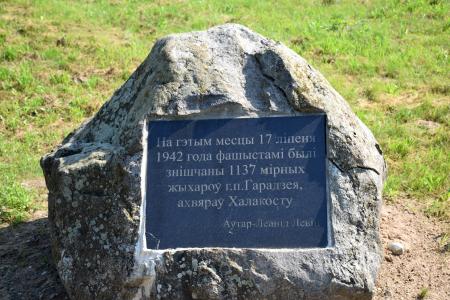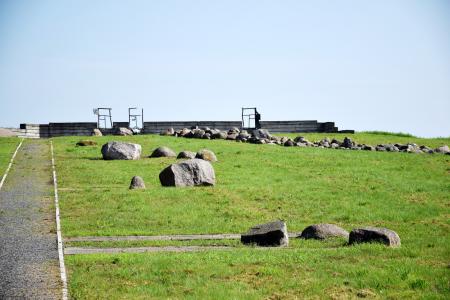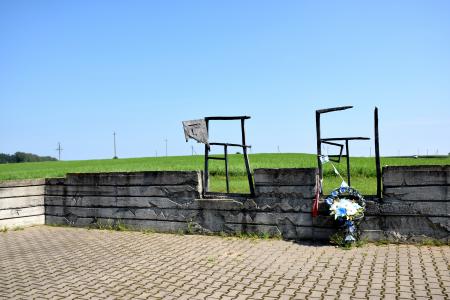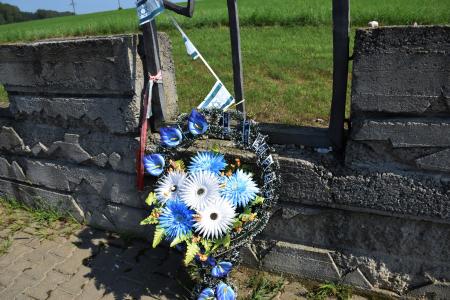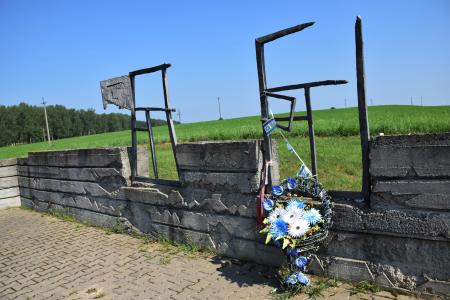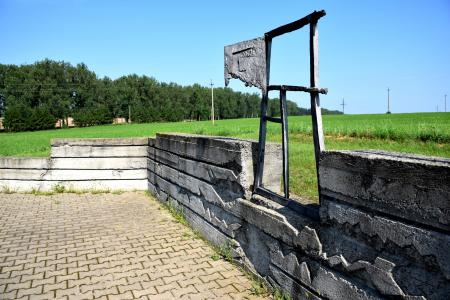Obj. ID: 48040
Memorials Memorial complex at the site of the murder of Jews in Gorodeya (Horodziej, Haradzeya, Gorodeia), Belarus, 2004

Who is Commemorated?
The Jews of Haradzeya killed in Holocaust
Description
The Haradzeya monument is shaped like the corner of a ruined Jewish dwelling, of which only a section of wall and three window frames remain. The 80-meter-long path to the killing site is an alley lined with rowan trees, whose red berries look like drops of blood. Nearby, there is a row of 1,137 boulders, symbolizing the 1,137 local victims of the Holocaust. At the beginning of the alley, there is a stone bearing a Belarusian-language plaque with a dedication to "annihilated 1,137 peaceful residents of Haradzeia – victims of the Holocaust." Although the ethnicity of the "peaceful residents" is still not specified, the word "Holocaust" is mentioned here.
Inscription
In Belarussian:
На гэтым месцы 17 ліпеня
1942 года фашыстамі былі
знішчаны 1137 мірных
жыхароў г.п.Гарадзея,
ахвяраў Халакосту
Аўтар-Леанід Левін
Translation: On this place, on July 17, / 1942, the Nazis / destroyed 1137 / civilians, residents / of Gorodeya, / victims of the / Holocaust / Author Leonid Levin
Commissioned by:
Nesvizh district executive committee, Gorodeya village executive committee, the Jewish community of Belarus with the support of the Simon Mark Lazarus Foundation (Great Britain)
sub-set tree:
Silumin
Natural stones - boulders
concrete wall 0.3 to 1.5 meters high and 30.30 meters long.
In September 1939, World War II broke out, and Haradzeya was occupied by the Soviets. By 1941, because of the influx of hundreds of Jewish refugees from the German-occupied areas of western Poland, the Jewish population of the village had grown to more than 1,100. In June 1941, the Soviet-German War began, and German troops entered Haradzeya on June 26.
Sometime in the fall of 1941, a ghetto was established in Haradzeya. On July 18 (or July 17, according to other sources), 1942, the Nazis liquidated the Haradzeya Ghetto. The inmates were assembled in the square and subjected to abuse, with some of them being killed on the spot. The survivors were then taken to a disused sand quarry and shot with machine guns.
Haradzeya was liberated by the Red Army on July 4, 1944.
In 1964, the Jewish victims were reburied in the area between the former cemeteries of Stoplce and Haradzeya. In 1990 a stele was erected at this reburial site. [Untold Stories]
The construction of the monument at the major killing site was initiated by the Belarus Holocaust Memorials Project. The architect Leonid Levin summarized his artistic idea in the following way:
"In Gorodeya, for example, I laid 1137 stones, one for each dead Jew. I put myself in the place of those executed, imagined myself among them. What are they thinking about in their last moments? Around fear, screams, tears. But some thoughts still come to mind even in this situation. They were shot on the mountain, they dug this hole themselves. From this mountain you can see Gorodeya, where they lived. Some of them looked at the streets where they lived. Streets, houses, friends, neighbors. 300 Belarusians stayed in these houses, and they were driven here. The houses were on fire. Therefore, here are the corners of houses, burnt windows and ... a lot of stones. I arranged these stones with the thought that the dead turned into this stone, that they live next to us". [Walk on the edge]
The Opening Ceremony took place on the 18th of July, 2004 - the day of the destruction of the Gorodeya Ghetto. The Opening Ceremony was attended by representatives of the regional authorities, the Ambassador of the State of Israel, USA, Great Britain, Germany, Jewish public organizations, rabbis, local Orthodox and Catholic priests, the author of the Memorial, sponsors, residents of Gorodeya, and nearby villages.
Memorial ceremonies take place on July 3rd and May 9th (Victory Day in Belarus) еаch year. Groups from Belarus and other countries visit the memorial during the year.
"Gorodeya," Belarus Holocaust Memorials Project, https://www.belarusmemorials.com/memorials/minsk/gorodeya/ (accessed March 19, 2023)
"Horodziej,"
Untold Stories - Murder Sites of Jews in Occupied Territories of the USSR (Yad Vashem project), https://collections.yadvashem.org/en/untold-stories/community/14622478.
Levin, Leonid, MomentsI (Minsk, 2013) 19-20
Levin, Leonid. Khatyn' (Minsk: Asobny Dakh: 2005), pp. 108-110.
Levina, Galina, "Gorodeya – pamiatnik zhertvam Holokosta. Iz poslednikh arkhitektora Leonida Levina" Arkhitekturnyi Biulleten' 2(89) (2006): 178-179. [In Russian], https://archi.ru/press/world/7236/gorodeya-pamyatnik-zhertvam-holokosta-iz-poslednih-rabot-arhitektora-leonida-levinabelarus (accessed February 27, 2023)
"Memory of a victim of the Gorodeya ghetto" planeta BELARUS, https://planetabelarus.by/sights/memorial-zhertvam-gorodeyskogo-getto/ (accessed February 27, 2023)
Sahm, Astrid, Architektur als Gratwanderung. Leonid Levin – ein Werk als Brücke von Gedächtnis und Gegenwart (Minsk: IBB, 2008)
Smilovitsky, Leonid. "Gorodeya," Most, June 05 and 12, 2019, no. 991, 992 [In Russian], https://cja.huji.ac.il/external_texts_db/Haradzeya_Most_05_06_2019_12_06_2019.pdf (accessed February 28, 2023)
"Walk on the edge. Architecture as a bridge between the past and the present in the work of Leonid Levin", General editorial Astrid Zahm. Minsk, 2008.




